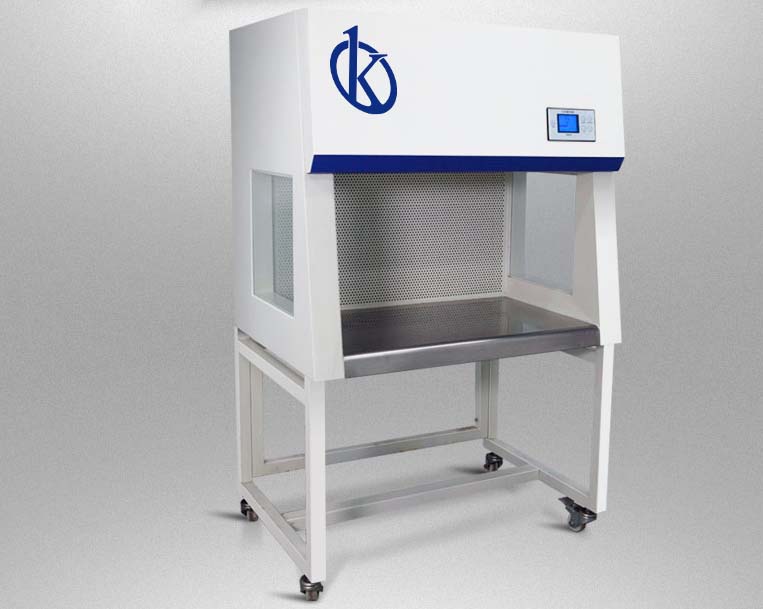History
At the beginning of the 20th century, the German scientist Robert Koch constructed the first ‘bio-containment’ cabinet after discovering that germs could float in air. Despite various leaks and design flaws, this system allowed Koch to work safely with anthrax, tuberculosis and cholera.
What to do and what not to do
DO:
• Do place containment trays or absorbent drapes under experiments to catch spills and to ease cleanup.
• Do operate the BSC sash at the manufacturers design criteria.
• Do operate the BSC for approximately 5 minutes prior to use.
• Do wipe down unit work surfaces with appropriate disinfectant prior to using BSC for sterility purposes, and after the completion of work, but before unit has been turned off.
• Do monitor alarms, pressure gauges or flow indicators for any major fluctuation or changes possibly indicating a problem with the unit.
DON’T:
• Don’t use a BSC unless there is a current certification label attached.
• Don’t overload the containment area or block front, side or rear air grills which will reduce or restrict air flow and compromise product protection and /or personnel protection.
• Don’t use the BSC for storage.
• Don’t change baffle, damper, speed control settings.
• Don’t lean into the BSC so that the user’s head is inside the plane of the BSC face.
• Don’t operate an ultraviolet light while working in the BSC.
• Don’t operate an ultraviolet light when occupants are in the laboratory unless the sash is closed completely and it is known to block UV light.
• Don’t use gas in cabinets.
• Don’t use open flame in cabinets.
Recommended location of Biological Safety Cabinets within the Laboratory
The ideal location for the biological safety cabinet is remote from the entry (i.e., the rear of the laboratory away
from traffic), since people walking parallel to the face of a BSC can disrupt the air curtain. The air curtain
created at the front of the cabinet is quite fragile, amounting to a nominal inward and downward velocity of 1
mph. Open windows, air supply registers, portable fans or laboratory equipment that creates air movement (e.g.,
centrifuges, vacuum pumps) should not be located near the BSC. Similarly, chemical fume hoods must not be located close to BSCs.
There are numerous risk factors involved in the daily basis routine in any kind of laboratory. Therefore, the lab’s personnel need to be on constant watch and care of every activity that is done in the laboratory. Risk factors can be high voltages, high and low pressures and temperatures, corrosive and toxic chemicals, and biohazards including infective organisms and their toxins. That is why Biosafety Cabinets are fundamental devices inside the laboratory.
Class I Biosafety Cabinets provide personnel and environmental protection inside the laboratory. They have the most basic and rudimentary design among all of the biological safety cabinetry that is available in the market. The way they work is when a stream of inward air moves into the cabinet with aerosols during microbiological manipulations, then passes through a filtration system trapping all airborne particles and contaminants. The process finishes when decontaminated air is exhausted from the cabinet.
Class I Biosafety Cabinets
You should know that these biosafety cabinets protect the operator and the environment from any biohazards exposure, but they do not protect samples from coming into contact with airborne contaminants that may be present in room air. That is why there is a risk of cross-contamination that might affect the experiment you are performing. Another important thing you should be aware of is that all Class I biosafety cabinets are suitable for work with microbiological agents assigned to biosafety levels 1, 2 and 3.
As you may know by now, Class I Biosafety Cabinets are designed for general microbiological research with low and moderate risk agents. These cabinets work zone is typically much smaller than a chemical fume hood and you should know that their work zone is geared for working with biologicals agents which procedures dictates the use of moderate amounts of volatile liquids, which are not suitable for recirculating cabinets.
Class I Biosafety Cabinets function
The way these cabinets work is when unfiltered room air is drawn through and access opening, providing, as you know, personnel protection, then the air goes across the work surface, through an exhaust plenum and out the top. However, there is one extremely important thing a Class I biosafety cabinet must have and that is that inward flow of air must be maintained at a minimum inflow velocity of 75 linear feet per minute (FPM) through the front access opening. We remind you the following features about these safety cabinets:
- A Class I cabinet does not protect the product from contamination because dirty room air constantly enters the cabinet front to flow across the work surface.
- As a partial containment unit, the Class I cabinet is suitable for work involving low to moderate risk agents (biosafety levels 1, 2 and 3) where there is a need for containment, but not for product protection.
- Unlike conventional fume hoods, the HEPA filter in the Class I cabinet protects the environment by filtering air before it is exhausted.
- Personnel protection is made possible by constant movement of air into the cabinet and away from the user.
In case you are wondering about the cabinet’s maintenance, they need to be taken care of on a regular basis. You should constantly check the airflow and the filter capacities, because they have a limited lifespan – determined by the air quality within the laboratory space and the amount of particles and aerosols generated inside the Biosafety Cabinet’s work zone. About this aspect, there is to know that trained personnel are the ones that are able to handle the filters, because they might be contaminated.
Learn more visiting our Class I Biosafety Cabinets. Visit our catalog HERE

